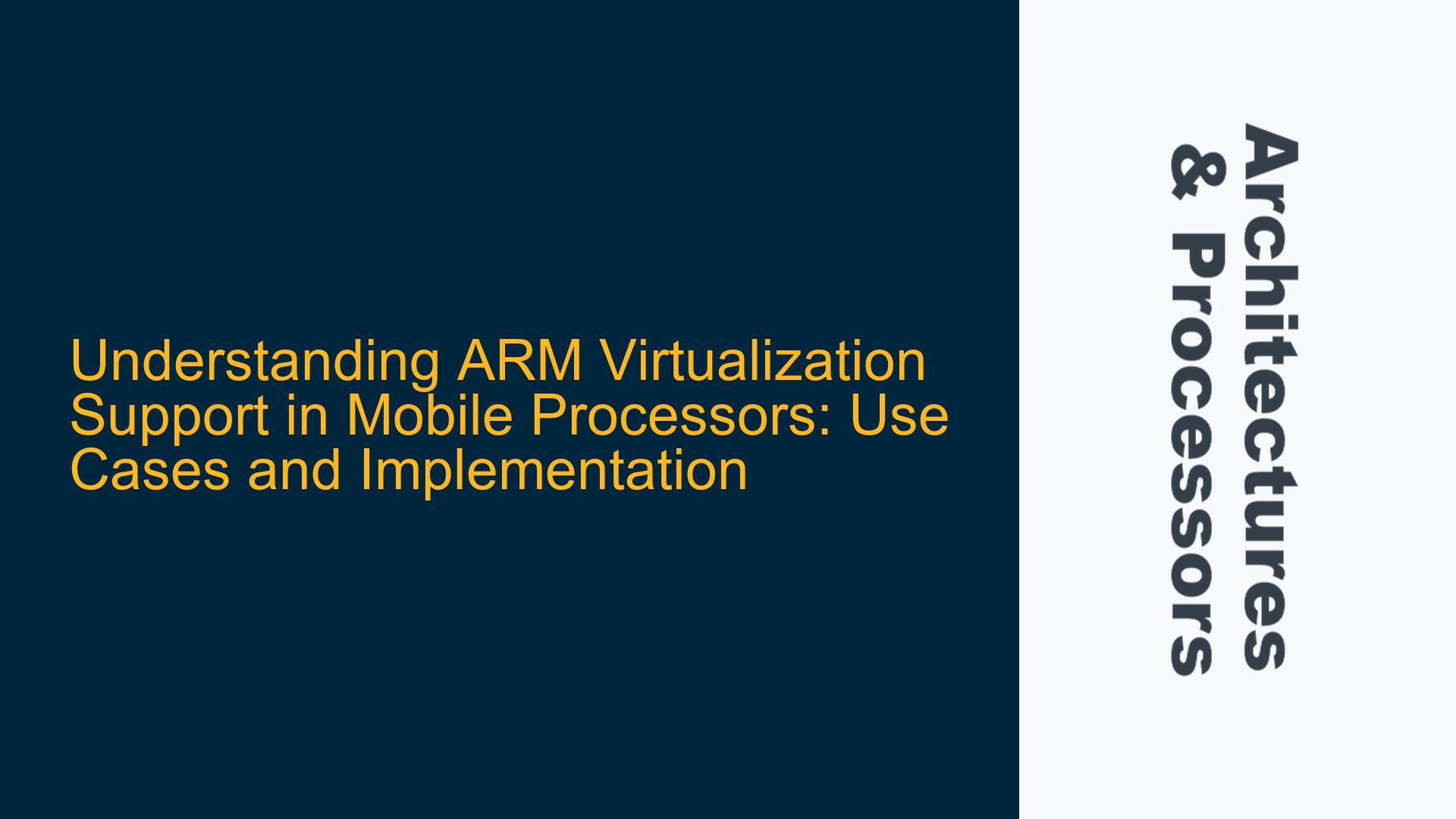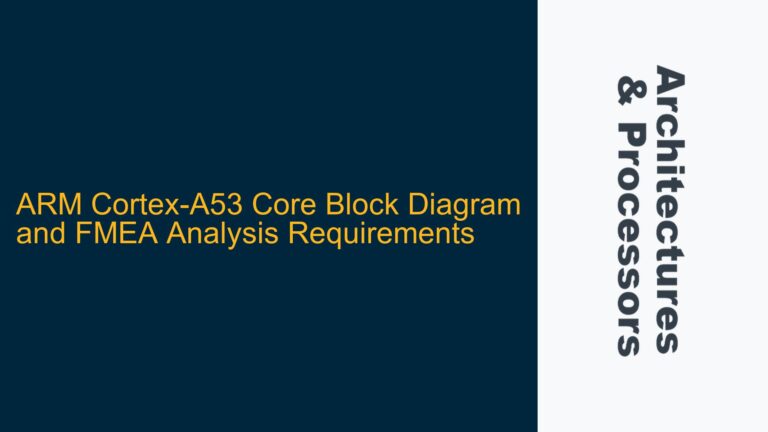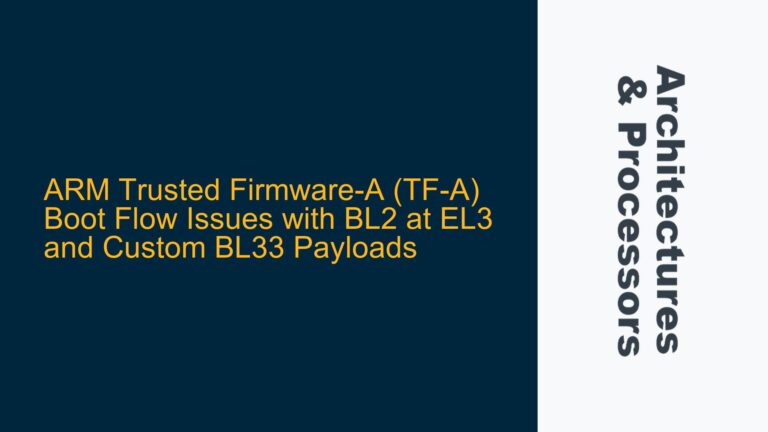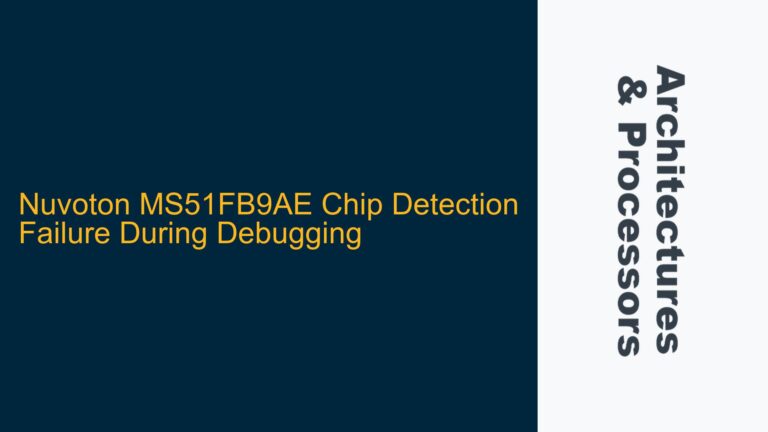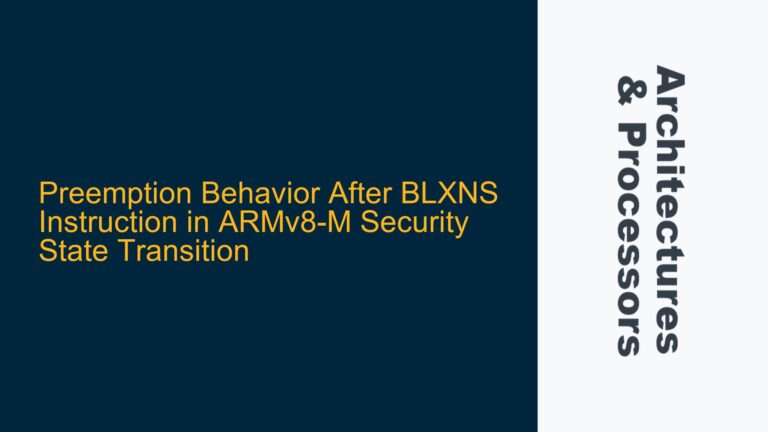ARM Virtualization in Mobile: Beyond Single OS Assumptions
The assumption that mobile devices run only one operating system at a time is a common misconception. While it is true that most mobile devices are designed to operate under a single primary OS, such as Android or iOS, the need for virtualization support in ARM-based mobile processors arises from a variety of advanced use cases that go beyond traditional desktop-style virtualization. ARM’s virtualization extensions, introduced in ARMv7 and significantly enhanced in ARMv8, provide hardware support for running multiple isolated environments on a single physical processor. These environments can include not only full operating systems but also lightweight kernels, secure worlds, and real-time operating systems (RTOS).
The primary driver for virtualization in mobile devices is the need for security, isolation, and efficient resource management. For instance, mobile devices often handle sensitive data, such as biometric information, payment credentials, and personal communications. Virtualization allows for the creation of secure enclaves or trusted execution environments (TEEs) that are isolated from the main OS, ensuring that sensitive operations are protected from potential malware or unauthorized access. Additionally, virtualization enables the coexistence of multiple operating systems or environments on the same hardware, which is particularly useful for development, testing, and specialized applications like automotive systems or IoT gateways.
ARM’s virtualization features are implemented through the ARM Hypervisor, which provides the necessary hardware support for creating and managing virtual machines (VMs). The hypervisor operates at a higher privilege level than the operating system, allowing it to control access to physical resources such as CPU cores, memory, and peripherals. This architecture ensures that each virtual machine operates independently, with its own isolated memory space and resource allocation. The hypervisor also handles context switching between virtual machines, ensuring that transitions are efficient and secure.
One of the key use cases for ARM virtualization in mobile devices is the Android Virtualization Framework (AVF). The AVF leverages ARM’s virtualization extensions to enable the creation of virtual machines that can run different versions of Android or even entirely different operating systems. This capability is particularly useful for developers who need to test their applications across multiple environments without requiring separate physical devices. Additionally, the AVF can be used to create secure environments for running sensitive applications, such as mobile payment systems or enterprise security solutions.
Another important use case for ARM virtualization in mobile devices is the implementation of trusted execution environments (TEEs). TEEs are isolated environments that run alongside the main operating system and are designed to handle sensitive operations, such as cryptographic key management or secure boot processes. ARM’s TrustZone technology, which is closely related to virtualization, provides hardware support for creating TEEs by dividing the processor into two worlds: the normal world (where the main OS runs) and the secure world (where the TEE operates). Virtualization extends this concept by allowing multiple secure environments to coexist, each with its own isolated resources and access controls.
In summary, ARM’s virtualization support in mobile processors is not about running multiple full-fledged operating systems simultaneously but rather about enabling advanced use cases that require security, isolation, and efficient resource management. The Android Virtualization Framework and trusted execution environments are just two examples of how virtualization is being used in mobile devices today. As mobile devices continue to evolve, the need for virtualization support is likely to grow, driven by the increasing complexity of applications and the need for robust security solutions.
Misconceptions About Mobile Virtualization and ARM’s Hypervisor Capabilities
One of the most common misconceptions about virtualization in mobile devices is that it is unnecessary because these devices typically run a single operating system. However, this view overlooks the fact that modern mobile devices are highly complex systems that often require multiple isolated environments to handle different tasks securely and efficiently. ARM’s virtualization extensions, particularly in the ARMv8 architecture, provide the necessary hardware support to meet these requirements.
The ARM Hypervisor is a critical component of ARM’s virtualization architecture. It operates at EL2 (Exception Level 2), which is a higher privilege level than the operating system (which typically runs at EL1). This allows the hypervisor to control access to physical resources and manage the creation and execution of virtual machines. Each virtual machine runs in its own isolated environment, with its own virtual memory space and resource allocation. The hypervisor ensures that virtual machines cannot interfere with each other, providing a high level of security and isolation.
One of the key features of the ARM Hypervisor is its ability to handle context switching between virtual machines efficiently. Context switching is the process of saving the state of one virtual machine and loading the state of another. This process must be fast and secure to ensure that virtual machines can run concurrently without significant performance overhead. ARM’s virtualization extensions include hardware support for context switching, which minimizes the time and resources required for this operation.
Another important aspect of ARM’s virtualization architecture is its support for nested virtualization. Nested virtualization allows a virtual machine to run its own hypervisor, which can in turn create and manage additional virtual machines. This capability is particularly useful for cloud computing and data center applications, where multiple layers of virtualization may be required. However, it also has applications in mobile devices, particularly in development and testing scenarios where multiple layers of virtualization can be used to simulate complex environments.
ARM’s virtualization extensions also include support for hardware-assisted virtualization of peripherals. This allows virtual machines to directly access physical hardware devices, such as network interfaces or storage controllers, without requiring intervention from the hypervisor. This capability is particularly important for mobile devices, where performance and power efficiency are critical. By allowing virtual machines to directly access hardware, ARM’s virtualization architecture minimizes the overhead associated with virtualization and ensures that virtual machines can run with near-native performance.
In addition to its hardware support for virtualization, ARM also provides a range of software tools and libraries to help developers implement virtualization in their applications. These tools include the ARM Trusted Firmware, which provides a reference implementation of a secure bootloader and runtime environment, and the ARM Virtualization Manager, which provides a framework for managing virtual machines and their resources. These tools make it easier for developers to take advantage of ARM’s virtualization capabilities and implement secure, efficient virtualization solutions in their mobile devices.
In conclusion, the misconception that virtualization is unnecessary in mobile devices stems from a narrow view of what virtualization can achieve. ARM’s virtualization extensions, particularly in the ARMv8 architecture, provide the hardware and software support needed to implement advanced use cases such as secure execution environments, efficient resource management, and nested virtualization. These capabilities are essential for meeting the security and performance requirements of modern mobile devices.
Implementing ARM Virtualization: Best Practices and Common Pitfalls
Implementing virtualization on ARM-based mobile processors requires a deep understanding of both the hardware and software aspects of ARM’s virtualization architecture. While ARM provides extensive documentation and tools to support virtualization, there are several common pitfalls that developers should be aware of to ensure a successful implementation.
One of the first steps in implementing ARM virtualization is to configure the hypervisor. The hypervisor is responsible for managing virtual machines and ensuring that they operate in isolated environments. This involves setting up the hypervisor’s memory management unit (MMU) to handle virtual memory translation and configuring the hypervisor’s exception handling to manage interrupts and exceptions generated by virtual machines. It is important to ensure that the hypervisor is properly configured to handle the specific requirements of the virtual machines it will be managing, such as the number of virtual machines, their memory requirements, and their access to physical resources.
Another critical aspect of implementing ARM virtualization is managing the transition between virtual machines and the hypervisor. This transition, known as a world switch, involves saving the state of the current virtual machine and loading the state of the next virtual machine. ARM’s virtualization extensions include hardware support for world switching, but it is still important to optimize this process to minimize performance overhead. This can be achieved by carefully managing the hypervisor’s context switch code and ensuring that it is optimized for the specific hardware platform being used.
One common pitfall in implementing ARM virtualization is failing to properly manage memory access permissions. Each virtual machine operates in its own isolated memory space, and it is the responsibility of the hypervisor to ensure that virtual machines cannot access each other’s memory. This requires careful configuration of the hypervisor’s MMU to enforce memory access permissions and prevent unauthorized access. Failure to properly configure memory access permissions can result in security vulnerabilities, such as virtual machines being able to access sensitive data belonging to other virtual machines or the hypervisor itself.
Another common issue in ARM virtualization is managing interrupts and exceptions. Virtual machines generate interrupts and exceptions just like physical machines, and it is the responsibility of the hypervisor to handle these events and ensure that they are routed to the correct virtual machine. ARM’s virtualization extensions include hardware support for interrupt virtualization, but it is still important to carefully configure the hypervisor’s interrupt handling code to ensure that interrupts are handled efficiently and securely. This includes configuring the hypervisor’s interrupt controller to prioritize interrupts and ensure that critical interrupts are handled in a timely manner.
In addition to these technical considerations, it is also important to consider the overall system architecture when implementing ARM virtualization. This includes considering the impact of virtualization on system performance, power consumption, and security. For example, running multiple virtual machines on a mobile device can increase power consumption, so it is important to optimize the hypervisor and virtual machines to minimize power usage. Similarly, virtualization can introduce additional security risks, so it is important to implement robust security measures, such as secure boot and runtime integrity checking, to protect against potential threats.
Finally, it is important to thoroughly test the virtualization implementation to ensure that it meets the required performance, security, and reliability standards. This includes testing the hypervisor’s ability to manage virtual machines, handle interrupts and exceptions, and enforce memory access permissions. It also includes testing the virtual machines themselves to ensure that they operate correctly in their isolated environments and do not interfere with each other or the hypervisor.
In conclusion, implementing ARM virtualization on mobile processors requires careful consideration of both hardware and software aspects. By following best practices and avoiding common pitfalls, developers can create secure, efficient virtualization solutions that meet the needs of modern mobile devices. This includes properly configuring the hypervisor, optimizing world switching, managing memory access permissions, handling interrupts and exceptions, and thoroughly testing the implementation to ensure that it meets the required standards.
